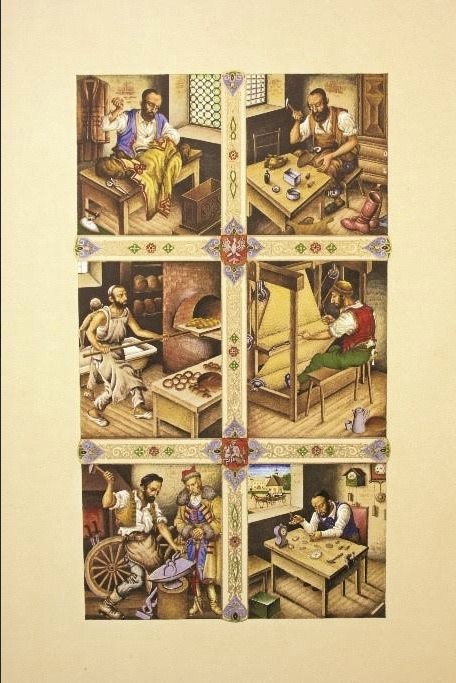Home » The beginning of jewish settlement and the development of the community until the 19th century
The earliest historical records of the Jews of Hrubieszow date back to the mid-15th century. They mention a merchant from Hrubieszow engaged in the import of fur and horses named Eliasz (Eliyahu), who traveled to Kyiv via Lutsk for business. A document from 1456 mentions Michael and his son Yehuda from Hrubieszow, who, under a special royal edict issued by King Casimir IV of Poland, were allowed to trade in wine and various goods throughout the country, and supply the needs of the royal court. By the mid-15th century, Jews in Hrubieszow had obtained several privileges, like engaging in the wine trade and managing the city’s tax office. During this period, Hrubieszow’s Jews played an essential role in the import and export of goods, traveling as far as Volhynia and Kyiv for business.
In 1578, King Stephen Báthory granted the Jews of Khmelnytsky a collective charter of rights, which included, among other things, permission to build a synagogue and residences for the rabbi and cantor, as well as a tax exemption for the community’s religious items. Like their Christian neighbors, Jews were allowed to work as craftsmen and merchants, to build homes, to open shops, to establish breweries, and to sell all kinds of foods and beverages. The Jewish community was required to pay also an annual tax to the palace — 15 “stones” of tallow for candle production in exchange for the right to slaughter animals in accordance with Jewish law. Additional taxes may have been imposed as well. This charter catalyzed the rapid development of the Jewish community.
In 1648, the forces of Bohdan Khmelnytsky invaded Hrubieszow, destroying the city’s houses and brutally massacring its Jewish inhabitants. Nathan ben Moses Hannover, a Ruthenian Jewish historian, Talmudist, and Kabbalist, wrote the following in his book, Yeven Metzulah (1653): “They committed great massacres in the holy communities of Tomaszów, Szczebrzeszyn, Turbin, Hrubieszow, and other neighboring communities, killing many thousands and tens of thousands of Jews.” These massacres, which were committed during what became known as the Khmelnytsky Uprising (1648–1649), annihilated the Jewish community of Hrubieszow. The survivors fled to surrounding villages, leaving the city ravaged by hunger and plague. However, the community was soon rebuilt, and it even experienced a religious revival. A yeshiva was established, led by Rabbi Yitzhak ben Yehuda Harif, and the city was recognized by the “Council of Four Lands,” the central governing body of Polish Jewry. By the mid-17th century, the Jewish community of Hrubieszow included over 300 Jews residing in 51 surrounding villages.
The tax burden on Hrubieszow’s Jews was immense. In addition to taxes collected by the community to fund its expenses, the Jews paid various levies to the king: poll taxes, property taxes, war debt levies, customs duties, bridge tolls, “market fees,” annual gifts to the local priest and the starosta (royal governor), and more.
In 1736, a fire devastated much of the city, destroying the synagogue and 27 Jewish homes. Following this disaster, the city began to recover, with the construction of the first brick inns. In 1715, a new brick synagogue was built. The Jewish quarter was located west of the new market square (Nowy Rynek), near the synagogue. Most buildings in the quarter were two-story brick houses, with shops and workshops on the ground floor, with the shop owners residing in the upper floor. This period saw an increase in the number of Jewish-owned shops, inns, and workshops, and a growing number of Jews became tailors, hatters, carpenters, tinsmiths, and painters, or worked in other trades. By the mid-18th century, Hrubieszow had 375 houses, 135 of which were owned by Jews, of which 15 inns and 13 shops were located in “stone houses” (brick buildings). Jews played a significant role in the trade of grain and agricultural produce from Ruthenia via the Bug and Vistula rivers to Gdańsk (Danzig).
